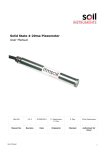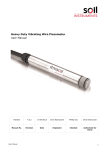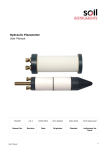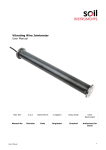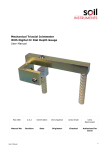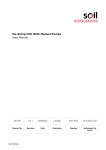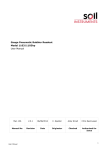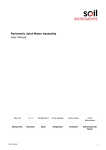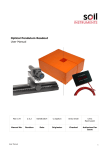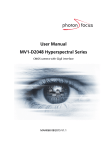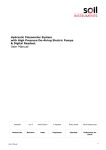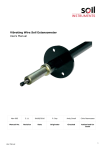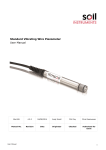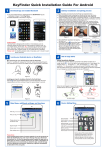Download MAN-051 Hydraulic Overflow Settlement Cell
Transcript
Hydraulic Overflow Settlement Cell User Manual Man051 2.0.2 04/07/2014 C.Spalton Andy Small Chris Rasmussen Manual No. Revision Date Originator Checked Authorised for Issue User Manual 1 Contents Section 1 : General Information ................................................................................................................. 3 Section 2 : Installation of Cell and Tubes ............................................................................................... 4 Section 3 : Monitoring Equipment.............................................................................................................. 5 3.01 3.01.1.1 3.01.1.2 3.01.1.3 3.02 3.02.1.1 3.02.1.2 3.02.1.3 Two Cylinder De-Airing Panel ..................................................................................................... 5 Filling the Panel ............................................................................................................................. 5 Operation......................................................................................................................................... 5 Recharging the Panel .................................................................................................................... 5 Standpipe Recording Panel .......................................................................................................... 6 Purging excess water from installed tubing ............................................................................. 6 Circulating water in overflow tube and priming standpipes ................................................. 6 Taking Readings ............................................................................................................................ 6 Section 4 : Water Back Pressure ................................................................................................................ 7 4.01 4.02 4.03 4.04 Filling ................................................................................................................................................ 7 Charging the Back Pressure Unit................................................................................................ 7 Operating Procedure ..................................................................................................................... 7 Taking Readings ............................................................................................................................ 8 Figure 1: Typical Arrangement For Hydraulic Overflow Settlement Cell ....................................... 9 Figure 2: Typical Arrangement For Hydraulic Overflow Settlement Cell With Back Pressure Unit .......................................................................................................................................................................... 10 User Manual 2 Section 1 : General Information The cell operates on a U-tube and overflow principle. It is similar in design to the system developed by the Building Research Station, England. The cell, a sealed container, is cast into a concrete block in the structure to be monitored and is connected by a nylon 'water' tube to a graduated standpipe in the instrument house. A second 'drain' tube allows surplus water to flow from the cell, and a third 'air' tube maintains the interior of the cell at atmospheric pressure. Before taking readings compressed air is used to remove water from the air tube and cell. The water tube is then filled with de-aired water by pumping a quantity sufficient to fill the tube and to remove any air bubbles that may have formed since the previous set of readings were taken. The graduated standpipe, which has also been filled, is then connected direct to the water tube using a three-way valve on the reading panel. The level of water in the standpipe falls until it reaches equilibrium with the level of an overflow weir in the cell. Small differences in level resulting from surface tension effects are practically constant from one reading to the next; thus settlement of the cell is reflected by an equal drop in water level at the standpipe. User Manual 3 Section 2 : Installation of Cell and Tubes A trench 0.5 to 1 metre deep is excavated to accommodate the tubes and cell. if possible the base of the trench should have a uniform gradient away from the cell in order to assist drainage to avoid the formation of air or water pockets in the tubing, though this is not essential. The location is carefully marked out and the cell placed in position. Water, air and drain tubes are connected to the cell allowing lengths equal to the distance between cell and measuring panel plus at least 5% to accommodate movement of the structure being monitored. The water tube comprises 8mm o/diameter nylon coated with 1mm thick polythene sheath. Approximately 25mm length of the polythene should be removed from the nylon and the connection to the cell fitting made directly on the nylon. Care should be taken not to damage the nylon tube when stripping the polythene coating. The air drain tube comprises 9.5mm o/diameter plain nylon tube. After fitting the tubes to the cell by tightening the brass compression fittings it is good practice to unscrew the nut and check that the brass sleeve is correctly positioned on the tubing. The correct function of the cell connected to its readout equipment is checked. The cell is then placed upright in suitable formwork on a concrete base, adjustment of the concrete thickness is made until the required initial reading at the instrument house is obtained. Care is taken to avoid kinks or sudden bends in the tubing. The formwork is then backfilled with concrete. The tubing is marked with coloured tapes for identification. The tube, bunched together and snaked in the trench to allow for ground movement, should be protected from mechanical damage by at least 150mm, of stone-free sand or clay above and below. The trench is backfilled, if possible, with excavated material, free from large stones and at natural water content. If the installation is in rockfill the tubes should be protected from damage by using an appropriately graded backfill. User Manual 4 Section 3 : Monitoring Equipment 3.01 Two Cylinder De-Airing Panel Figure 1 shows the two cylinder de-airing unit with its connections to the standpipe panel. Mount the panel vertically and level on the instrument house wall. Connect the busbar of the standpipe panel to the elbow fitting at the base of the cylinder B using a suitable length of nylon tubing. Connect the de-aired water supply to valve P. 3.01.1.1 Filling the Panel Initially all valves should be in the closed position. Attach a vacuum pump to valve E. Open valves E, G and N. Apply a vacuum to evacuate the bladder in cylinder B. Close valves E, G and N. Attach a suitable length of rubber hose to valve J with its other end in a container of clean water. By operating the vacuum pump and opening valves E and J, draw the clean water into cylinder A until it is seven-eighths full. First close valve J then valve E. Remove the vacuum pump and open valve E to release the vacuum from cylinder A. Attach the vacuum pump to valve G and with the de-aired water supply connected to valve P open both these valves. By applying a vacuum to cylinder B draw in the de-aired water until B is seven-eighths full. Close valves G and P. Remove the vacuum pump and open valve G. Attach the foot pressure pump to valve K. Open valve K and pressurise cylinder A. Open valve N inflating the bladder to expel the air remaining in cylinder B. Air bubbles clinging to the cylinder walls should be dislodged by vigorous slapping. Close valve G. air should also be bled from the busbar connection to the standpipes by loosening the stop end fitting at the end of the busbar and retightening. Close valve K. Attach the vacuum pump to E. open valves E, N and P and by applying a vacuum to cylinder A draw de-aired water into cylinder B. Close valves E, N and P. Remove the vacuum pump and open valve E to release the vacuum. Close valve N. The panel is now charged and ready for operation. 3.01.1.2 Operation To fill standpipes and tubing with de-aired water, open valve K and apply a pressure to cylinder A, as measured on the gauge. Open valve N thereby pressurising the bladder and the de-aired water in cylinder B. this de-aired water may be fed to standpipes and overflow tubes by opening valves (1), (2) and (3) on the standpipe panel. 3.01.1.3 Recharging the Panel Ensuring that valve K and valves (1) on the standpipe are closed, attach a vacuum pump to E. Open valves E, N and P and by applying a vacuum to cylinder A, draw de-aired water into cylinder B. User Manual 5 3.02 Standpipe Recording Panel Figure 1 shows a typical terminal arrangement for the most common reading arrangement. This method is suitable for installations where the crest of the overflow weir in the installed cell is at an elevation which lies within the vertical bounds of the calibrated standpipes of the recording panel and remains so throughout the monitoring period. The general operating procedure is as follows:- 3.02.1.1 Purging excess water from installed tubing Close valves (3) on each of the standpipe valve blocks. Set regulator on compressor to approximately 50 PSI (3.8 Bar) and connect to the AIR VALVE. Alternatively connect a foot pump to the AIR VALVE. Connect the AIR TUBE of each cell to the AIR VALVE in turn and allow air flow to continue for a minimum of 5 minutes or until all evidence of water returning via the related drain tube ceases. When no further flow in drain tubes is apparent close off compressed air supply and vent the air tube to atmosphere. Wait at least 5 minutes before proceeding further. 3.02.1.2 Circulating water in overflow tube and priming standpipes Prepare source of de-aired water in sufficient quantity to replace water in the length of overflow tube from measuring point to installed instrument plus 25% excess. Pressurise de-airing unit and open valves (1) and (2) in turn on each of the standpipes to be used and allow water to fill to within 50mm of the top of each unit. Reclose valves (2) in turn. Note water level in delivery cylinder of de-airing unit and record scale reading. When a quantity sufficient to replace existing water in this tube, plus 25% excess has been delivered (as indicated by the scale on the delivery cylinder of the de-airing unit) close off valve (1) on the related standpipe. Wait at least 15 minutes before proceeding to reading phase on purged cell. Repeat above procedure for other cells. 3.02.1.3 Taking Readings Ensure at least 15 minutes has elapsed, since overflow tube filling was completed. This delay is necessary to ensure that increased air pressure resulting from water flow into the installed tubing and cell has had time to dissipate to atmosphere via the air tube. Open valve (2) of the related standpipe whereupon the water level will start to fall to a reading level. Depending on the length of installed tubing, the time taken for the reading to stabilise as levels balance could vary from a few minutes to tens of minutes. Where falling standpipe water level is slow it is advisable to take readings at regular intervals (say 1 minute) after the time at which valve (2) was opened to determine when the level has stabilised. Record reading. User Manual 6 Section 4 : Water Back Pressure Figure 2 shows the backpressure and standpipe panel arrangement. This method is suitable for installation where the crest of the overflow weir in the installed cell is higher than the standpipe recording panel. The general operating procedure is as follows – Figure 2 shows the backpressure unit with its connections to the standpipe panel. Mount the panel in a vertical position to the instrument house wall. Using a suitable length of nylon tube connect the top of standpipe 3, to Valve W back pressure unit. Repeat procedure with all Standpipe/Back Pressure connections. 4.01 Filling Remove both tube connections from the top of the lower pot Z. Fill with 100ml of clean water, refit connections. approximately 4.02 Charging the Back Pressure Unit With all valves in the off position, connect the foot pump to valve connection Y. open valve, operate foot pump until water column in sight tube rises to approximately 1.5 metre. Close valve Y, disconnect foot pump. 4.03 Operating Procedure a) With the de-airing unit fully charged as per procedure 3.1 open valve N. b) Open valves 1 and 2 on standpipe 3; allow the water level in the sight tube to rise to approximately 1.5 metres, close valve 1. c) Open valve W. balance. d) Open valve 1. Allow water level in standpipe to rise to approximately 2.45 metres. It will be noted that the backpressure water level should increase by the same amount. Allow a few minutes for standpipe and backpressure water columns to It is important to prevent the overspill of water into the standpipe backpressure air tube connections. During this operation the 2.45 metre level should not be exceeded. If however this should occur it will be necessary to remove all water via valve 3 and re-pressurise as per procedure 4.02. User Manual 7 4.04 Taking Readings Ensure at least 15 minutes has elapsed since the overflow tube filling procedure was completed. Open valve 3 on the related standpipe, whereupon the water level will start to fall to its reading level. The time taken to stabilise will depend on the installed tube length. When stable add together standpipe and back pressure reading and record. Bell Lane, Uckfield, East Sussex t: +44 (0) 1825 765044 e: [email protected] TN22 1QL United Kingdom f: +44 (0) 1825 744398 w: www.itmsoil.com Soil Instruments Ltd. Registered in England. Number: 07960087. Registered Office: 5th Floor, 24 Old Bond Street, London, W1S 4AW User Manual 8 HYDRAULIC OVERFLOW SETTLEMENT CELL Figure 1: Typical Arrangement For Hydraulic Overflow Settlement Cell S ta nd pi pe P an el T ypi c al Ove rfl ow S ettl em e nt C el l Fo ot P um p F G A Dra in Tube K A ir Tub e E Overfl ow Tub e T wo C yl in der De -A i ri ng U ni t B 2 3 1 P J L H C om pres s or Or Fo ot P um p User Manual A ir Va lve 9 HYDRAULIC OVERFLOW SETTLEMENT CELL Figure 2: Typical Arrangement For Hydraulic Overflow Settlement Cell With Back Pressure Unit B ack P ressure Uni t S tand pi pe P anel W X Typical Overfl ow S ettl ement Cell Two Cyl inder De-A iri ng Unit E F F Y J K 3 1 3 L N Drain Tube 2 A ir Tube P 2 3 1 1 Overflow Tube 2 Z Foot P ump Compressor Or A ir V alve Foot P ump User Manual 10










